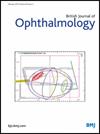Efficacy of spectacle lenses for myopia control: a meta-analysis of randomised controlled trials
IF 3.5
2区 医学
Q1 OPHTHALMOLOGY
引用次数: 0
Abstract
Purpose To determine the effects of advanced spectacle lens technologies on changes in spherical equivalent of refraction (SER) and axial length (AL) elongation in slowing down the progression of myopia in children and adolescents, by synthesising data from randomised controlled trials (RCTs). Methods A systematic review and meta-analysis was conducted to identify all RCTs up to 27 February 2025 that compared intervention groups with myopia control lenses and control groups with standard single vision lenses (SVLs). Data from eligible studies were extracted into specially-designed data collection forms without changing the original values. Means and SD for continuous outcomes were determined and imported into RevMan. Results This meta-analysis included 23 RCTs with a total of 13.315 subjects. Compared with SVLs, myopia control lenses significantly reduced AL (−0.15 mm; 95% CI −0.20 to −0.09; p<0.00001) and SER progression (−0.31 D; 95% CI −0.42 to −0.20; p<0.00001). Highly Aspherical Lenslet lenses significantly reduced AL (−0.28 mm; 95% CI −0.37 to −0.19) and SER progression (−0.52 D; 95% CI −0.84 to −0.20). Defocus Incorporated Multiple Segments lenses also significantly reduced SER (−0.45 D; 95% CI −0.65 to −0.26), although only one eligible RCT reported AL data. Other lens types had modest or variable effects. Conclusions This meta-analysis provides an up-to-date and detailed comparative evaluation of spectacle lens designs for myopia control, based exclusively on RCTs. These findings support the use of specialty lenses as an effective, non-invasive strategy to reduce the risks associated with high-myopia and guide optimal lens selection in clinical practice. PROSPERO registration number CRD420251009898 All data relevant to the study are included in the article or uploaded as supplementary information.眼镜镜片控制近视的功效:随机对照试验的荟萃分析
目的通过综合随机对照试验(RCTs)的数据,确定先进的眼镜镜片技术对儿童和青少年的球面等效折射(SER)和轴长(AL)伸长的影响,以减缓近视的进展。方法对截至2025年2月27日的所有rct进行系统回顾和荟萃分析,以比较使用近视对照镜片的干预组和使用标准单视力镜片(SVLs)的对照组。在不改变原始值的情况下,将符合条件的研究数据提取到专门设计的数据收集表格中。确定连续结果的均值和SD并导入RevMan。结果本meta分析纳入23项随机对照试验,共13315名受试者。与svl相比,近视对照镜片显著降低了AL (- 0.15 mm, 95% CI - 0.20至- 0.09,p<0.00001)和SER进展(- 0.31 D, 95% CI - 0.42至- 0.20,p<0.00001)。高度非球面透镜透镜显著降低AL (- 0.28 mm; 95% CI - 0.37至- 0.19)和SER进展(- 0.52 D; 95% CI - 0.84至- 0.20)。尽管只有一项符合条件的RCT报告了AL数据,但散焦合并多段透镜也显著降低了SER (- 0.45 D; 95% CI - 0.65至- 0.26)。其他类型的晶状体效果一般或不同。结论:本荟萃分析提供了最新的、详细的、基于随机对照试验的近视控制眼镜镜片设计的比较评价。这些发现支持使用特殊镜片作为一种有效的、非侵入性的策略来降低与高度近视相关的风险,并指导临床实践中最佳的镜片选择。PROSPERO注册号CRD420251009898与研究相关的所有数据都包含在文章中或作为补充信息上传。
本文章由计算机程序翻译,如有差异,请以英文原文为准。
求助全文
约1分钟内获得全文
求助全文
来源期刊
CiteScore
10.30
自引率
2.40%
发文量
213
审稿时长
3-6 weeks
期刊介绍:
The British Journal of Ophthalmology (BJO) is an international peer-reviewed journal for ophthalmologists and visual science specialists. BJO publishes clinical investigations, clinical observations, and clinically relevant laboratory investigations related to ophthalmology. It also provides major reviews and also publishes manuscripts covering regional issues in a global context.

 求助内容:
求助内容: 应助结果提醒方式:
应助结果提醒方式:


